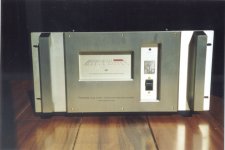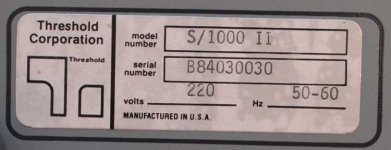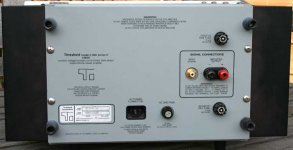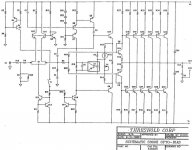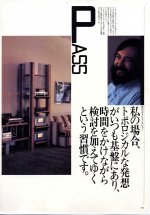Hello (again),
Just acquired a pair of Threshold S/1000 Series II.
1. Know that it has a bridged topology to get the rated 500 Watts at 8 Ohm that's why I wonder if it's stable at the lower loads? They have to drive Acoustat 2 + 2 Electrostatics.
2. Should I perform any prefailure mods with these 25 years old amps?
3. Does anybody know the difference between the initial Series and the Series II?
Thanks in advance,
Robert
Just acquired a pair of Threshold S/1000 Series II.
1. Know that it has a bridged topology to get the rated 500 Watts at 8 Ohm that's why I wonder if it's stable at the lower loads? They have to drive Acoustat 2 + 2 Electrostatics.
2. Should I perform any prefailure mods with these 25 years old amps?
3. Does anybody know the difference between the initial Series and the Series II?
Thanks in advance,
Robert
Attachments
I would go ahead and use them and see what you get before
worrying about rapleacing capacitors, etc.
I don't recall a Series 2. I cruised through the old brochures up
to '91 when I left, and I don't see mention of it.
😎
worrying about rapleacing capacitors, etc.
I don't recall a Series 2. I cruised through the old brochures up
to '91 when I left, and I don't see mention of it.
😎
Thanks for your information.
I have some pictures of these Series II designation.
The first Series II S/1000 amps were produced in 1983 according to the serial badge at the back.
According to the serials these sampels I own are produced in januari and March of 1984 and are designated as Series II also on the Threshold stylish T badge in the front it says Series II.
Can you recall the difference between the first offerings of these amps and the Series II.
Do you think the bridged topology is stable enough to drive low efficient and low impedance Acoustats. I know J. Gordon Holt got good results with the massive parallel SA/1 on the SoundLab A1 or A3.
The picture I attached says: 84030030
Probably means April 1984 number 30?
I have some pictures of these Series II designation.
The first Series II S/1000 amps were produced in 1983 according to the serial badge at the back.
According to the serials these sampels I own are produced in januari and March of 1984 and are designated as Series II also on the Threshold stylish T badge in the front it says Series II.
Can you recall the difference between the first offerings of these amps and the Series II.
Do you think the bridged topology is stable enough to drive low efficient and low impedance Acoustats. I know J. Gordon Holt got good results with the massive parallel SA/1 on the SoundLab A1 or A3.
The picture I attached says: 84030030
Probably means April 1984 number 30?
Attachments
Frankly, I don't recall what was meant by Series II back in 1983.
If you compare these models to the original Stasis 1,2 and 3 you
will find that besides a silver faceplate, the circuit has deleted the
cascoding of the output stage. They should not have difficulty driving
the Sound Labs.
😎
If you compare these models to the original Stasis 1,2 and 3 you
will find that besides a silver faceplate, the circuit has deleted the
cascoding of the output stage. They should not have difficulty driving
the Sound Labs.
😎
Thanks again. It's indeed a long time ago.
You together with Dan D'Agostino took the effort to mention a major update (or was it René who saw it as commercial viable) on your products. The MLAS amplifiers I know of, the ML-2 and ML-3 had a total of four Series but never mentioned that, only on their schematics. They also got no people later asking about the differences 😉
I'll check the railvoltages, DC and bias/temperaturelevels on both units.
Bye Robert
You together with Dan D'Agostino took the effort to mention a major update (or was it René who saw it as commercial viable) on your products. The MLAS amplifiers I know of, the ML-2 and ML-3 had a total of four Series but never mentioned that, only on their schematics. They also got no people later asking about the differences 😉
I'll check the railvoltages, DC and bias/temperaturelevels on both units.
Bye Robert
Thanks George,
Off course I did some homework and scanned every thread which came up with my Searchquery 'Threshold'.
so I was pleased to find your schematics and copied them to my disk already yesterday. Don't want to bother you guys with questions that could be answered by reading this information on this Forum. So thanks again.
As I recall those amps from that era have been reincarnated in three different versions:
The first one with obviously no Series designation on them, Series II and the optical bias versions.
Only the substituded S/150 (by the S/200) and the S/1000 never made it to the latest incarnation, the optical bias version. The SA/1, 2 and 3 appeared on the scene simultaneously with the Series II versions of
the AB class amps so these Class A designs never bore that designation (Series II), later they also
got updated to the optical bias version.
If Nelson does not recall the differences between the two first Series I'm afraid nobody does, maybe Grey could be of some assistance in this matter.
Off course I did some homework and scanned every thread which came up with my Searchquery 'Threshold'.
so I was pleased to find your schematics and copied them to my disk already yesterday. Don't want to bother you guys with questions that could be answered by reading this information on this Forum. So thanks again.
As I recall those amps from that era have been reincarnated in three different versions:
The first one with obviously no Series designation on them, Series II and the optical bias versions.
Only the substituded S/150 (by the S/200) and the S/1000 never made it to the latest incarnation, the optical bias version. The SA/1, 2 and 3 appeared on the scene simultaneously with the Series II versions of
the AB class amps so these Class A designs never bore that designation (Series II), later they also
got updated to the optical bias version.
If Nelson does not recall the differences between the two first Series I'm afraid nobody does, maybe Grey could be of some assistance in this matter.
This is a special about Nelson Pass from a Japanese Audio Magazine in the early eighties, or maybe a architectural one with a photo of somebodies interior at that time and the interior does not look like as your typical cramped Japanese room but more like a spacier American one.
I don't know how to read Japanese but I do know three of the Audio items depicted:
Fet One pre-amp and two S/1000's.
So I reckon it must be Nelson's home or that of Rene Besné operating a pair of these amps that seems like orphans now...
I don't know how to read Japanese but I do know three of the Audio items depicted:
Fet One pre-amp and two S/1000's.
So I reckon it must be Nelson's home or that of Rene Besné operating a pair of these amps that seems like orphans now...
Attachments
Let's see,
Dan D'Agostino was only involved with Threshold by virtue of using
his offices at Dayton Wright to help with distribution in the early
years '75 to about '79. By the time the silver amps were designed,
he was busy with his own silver amps at Krell.
The magazine photo was in Stereo Sound and the living room shot
was Rene's, and the pic was published in '81.
By the way I do have a CD chock full of this stuff.
😎
Dan D'Agostino was only involved with Threshold by virtue of using
his offices at Dayton Wright to help with distribution in the early
years '75 to about '79. By the time the silver amps were designed,
he was busy with his own silver amps at Krell.
The magazine photo was in Stereo Sound and the living room shot
was Rene's, and the pic was published in '81.
By the way I do have a CD chock full of this stuff.
😎
I reckoned it was Rene's because in interviews you aways seemed to have setups with the smaller Thresholds (probably having more efficient speakers)
and Rene the bigger amps.
I saw some references at a www.passlabs.com/ np or /threshold dir at this forum but they were all deadlinks now you can't keep them forever of course. Together with a friend I'm in the progress of developing a highendclassics site with American audio equipment that defined the highend scene.
So I'm really interested in that CD.
Jon Soderbergh filled in the gap between the Series I and II versions and stated that the update dealed - apart from a rearrangement of the connectors at the back for the S/1000 - mainly with the audio-board to get a better grip with biasdrift and thermal runaway problems, that were definetely settled with the optical bias versions. I think all the designers of poweramps had their problems in the seventies and eighties to keep the bias at a stable level.
and Rene the bigger amps.
I saw some references at a www.passlabs.com/ np or /threshold dir at this forum but they were all deadlinks now you can't keep them forever of course. Together with a friend I'm in the progress of developing a highendclassics site with American audio equipment that defined the highend scene.
So I'm really interested in that CD.
Jon Soderbergh filled in the gap between the Series I and II versions and stated that the update dealed - apart from a rearrangement of the connectors at the back for the S/1000 - mainly with the audio-board to get a better grip with biasdrift and thermal runaway problems, that were definetely settled with the optical bias versions. I think all the designers of poweramps had their problems in the seventies and eighties to keep the bias at a stable level.
Biasproblems
Again, this is the second pair in Germany I encountered that has been modified from a Bridged configuration (a S/1000 setup) to a massive parallel configuration (like a SA/1) One of the audioboards has been taken out and the other one has been replaced by a goldcolored board. Railvoltage is 62.3 Volt good for a 170 Watts at 8 Ohm instead of the bridged 500 Watts rating of a S/1000.
The bias I measured over several emmitorresistors was very low somewhere between 4 and 6 mV. The coolingfins did not even become lukewarm.
Of course I tried to correct that but the blue Bourns oneturn trimmer for that purpose was a pain in the ***. Only a really small fraction of a turn gave a increase to 200 mV and the toroid started to hum immediately. I managed to get a value for both amps at approx. 90 mV (over a 1.3 to 1.6 Ohm resistor) resulting in 60 mA biascurrent multiply that by 40 (transitors)gives 2.4 A = 46 Watts Class A at 8 Ohms. The coolingfins became pretty warm but certainly not to hot to touch and you could leave them there for more then ten seconds without real discomfort.
The I put the amps back together, top- and backplate turned them on again and the became only luke warm. I took off the lid again measured the bias and found out that it had sunk to 35 mV. I led the toplate of and slowly it started to rise again to 60 mV.
The next day I coldstarted them and and they both warmed up within 30 minutes with both plates on they became pretty warm/hot. Opened the topplate again and measured 100 mV.
Ergo I see no way to stabilize the amp temperature/biascurrent because I don't no what to expect and even with only the backplate of and a setting of 90 mV obtained within half hour warming up time, then switching of and as quick as possible attaching the backplate in 5 minutes and switch the amp back on again, sees a sharp drop in temperature again as stated above. Should I start with 130 - 150 mV and hope that after putting both plates on again the settles for 90 mV?
To get the specified 160 Watts Class A I would need 4.5 Amperes of biasing 112 mA per transistor. The hardware and the configuration is the same as a SA/1 so I pressume it should be possible.
Hope that anybody can give me a advice how to proceed with this matter.
It sounds by the way very nice on my set.
Thanks in advance
Again, this is the second pair in Germany I encountered that has been modified from a Bridged configuration (a S/1000 setup) to a massive parallel configuration (like a SA/1) One of the audioboards has been taken out and the other one has been replaced by a goldcolored board. Railvoltage is 62.3 Volt good for a 170 Watts at 8 Ohm instead of the bridged 500 Watts rating of a S/1000.
The bias I measured over several emmitorresistors was very low somewhere between 4 and 6 mV. The coolingfins did not even become lukewarm.
Of course I tried to correct that but the blue Bourns oneturn trimmer for that purpose was a pain in the ***. Only a really small fraction of a turn gave a increase to 200 mV and the toroid started to hum immediately. I managed to get a value for both amps at approx. 90 mV (over a 1.3 to 1.6 Ohm resistor) resulting in 60 mA biascurrent multiply that by 40 (transitors)gives 2.4 A = 46 Watts Class A at 8 Ohms. The coolingfins became pretty warm but certainly not to hot to touch and you could leave them there for more then ten seconds without real discomfort.
The I put the amps back together, top- and backplate turned them on again and the became only luke warm. I took off the lid again measured the bias and found out that it had sunk to 35 mV. I led the toplate of and slowly it started to rise again to 60 mV.
The next day I coldstarted them and and they both warmed up within 30 minutes with both plates on they became pretty warm/hot. Opened the topplate again and measured 100 mV.
Ergo I see no way to stabilize the amp temperature/biascurrent because I don't no what to expect and even with only the backplate of and a setting of 90 mV obtained within half hour warming up time, then switching of and as quick as possible attaching the backplate in 5 minutes and switch the amp back on again, sees a sharp drop in temperature again as stated above. Should I start with 130 - 150 mV and hope that after putting both plates on again the settles for 90 mV?
To get the specified 160 Watts Class A I would need 4.5 Amperes of biasing 112 mA per transistor. The hardware and the configuration is the same as a SA/1 so I pressume it should be possible.
Hope that anybody can give me a advice how to proceed with this matter.
It sounds by the way very nice on my set.
Thanks in advance
It's a little difficult to say, given that the amplifier may have a new
unknown front end board.
😎
unknown front end board.
😎
It's definitely a Thresholdboard with the number:
540305A probably an A at the end to indicate a revision.
I think Threshold supplied a couple of these boards to update a S/1000 (Series II) to a SA/1 for people that wanted the latest technology with these amps.
It's basically the same hardware rearranged.
The two larger boards with the 40 powertransistors on them has the same type coppertraces and lettertype to designate them. These start with 52xxxxx.
Jon Soderbergh advised me to switch the oneturn 5kOhm trimmer with a multiturn version from Bourns or Spectrol.
I deduce when the top- and backplate are of the chassis, a sensor detects a temperature fall and compensates this with a biascurrent increase. This consistent behaviour, the only problem is that I have to take the backplate of to reach the biastrimmers and it's a kind of guess at which position I have to turn the trimmer to get a satisfactory level when the amp is closed and has settled down.
I never experienced this sensisitive behaviour with other highend amplifiers when adjusting the bias.
From the center of the audioboard, a component with two black leads soldered to it, protrudes into a hole through the silver metal chassis (where the 20 transistors are mounted on) towards the coolingblocks. It is covered with a transparent kind of plastic. I reckon it's a temperature sensor to monitor a possible overheating situation or it has something to do with the biascircuit, or maybe even both.
Can you sir (or anybody else) relate to the mods or this kind of behaviour which I have pictured as precisely as possible.
540305A probably an A at the end to indicate a revision.
I think Threshold supplied a couple of these boards to update a S/1000 (Series II) to a SA/1 for people that wanted the latest technology with these amps.
It's basically the same hardware rearranged.
The two larger boards with the 40 powertransistors on them has the same type coppertraces and lettertype to designate them. These start with 52xxxxx.
Jon Soderbergh advised me to switch the oneturn 5kOhm trimmer with a multiturn version from Bourns or Spectrol.
I deduce when the top- and backplate are of the chassis, a sensor detects a temperature fall and compensates this with a biascurrent increase. This consistent behaviour, the only problem is that I have to take the backplate of to reach the biastrimmers and it's a kind of guess at which position I have to turn the trimmer to get a satisfactory level when the amp is closed and has settled down.
I never experienced this sensisitive behaviour with other highend amplifiers when adjusting the bias.
From the center of the audioboard, a component with two black leads soldered to it, protrudes into a hole through the silver metal chassis (where the 20 transistors are mounted on) towards the coolingblocks. It is covered with a transparent kind of plastic. I reckon it's a temperature sensor to monitor a possible overheating situation or it has something to do with the biascircuit, or maybe even both.
Can you sir (or anybody else) relate to the mods or this kind of behaviour which I have pictured as precisely as possible.
I can only tell you that the thing with two black leads and a clear case
is a thermal cutout, which opens when the amp overheats. It is not
intended as a bias control, although I suppose you could interpret
shutting the channel down as a method of controlling bias.
Who did the work modifying the amplifier?
😎
is a thermal cutout, which opens when the amp overheats. It is not
intended as a bias control, although I suppose you could interpret
shutting the channel down as a method of controlling bias.
Who did the work modifying the amplifier?
😎
- Status
- Not open for further replies.
- Home
- Amplifiers
- Pass Labs
- Threshold S/1000 Series II
